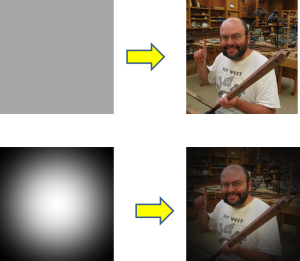Difference between revisions of "Flat-field correction"
(→Overview) |
(→Overview) |
||
| Line 5: | Line 5: | ||
==Overview== | ==Overview== | ||
[[File:Nonuniform Illumination.png|thumb|300 px|right|Illustration of the effect of nonuniform illumination. The image appears darker at the edges due to the weaker illumination.]] | [[File:Nonuniform Illumination.png|thumb|300 px|right|Illustration of the effect of nonuniform illumination. The image appears darker at the edges due to the weaker illumination.]] | ||
| − | Before you record any images, it is a very good idea to adjust your microscope optics to make the illumination is as good as possible. Even if you adjust the illuminator perfectly, the light intensity won't be exactly the same everywhere in the field of view. In most cases, the illumination is brightest in the middle of the image, with a steady decrease in intensity as you approach the edges of the field of view. Dirt or other flaws in the illumination system can also cause variation in the illumination. Another source of non-uniformity is pixel | + | Before you record any images, it is a very good idea to adjust your microscope optics to make the illumination is as good as possible. Even if you adjust the illuminator perfectly, the light intensity won't be exactly the same everywhere in the field of view. In most cases, the illumination is brightest in the middle of the image, with a steady decrease in intensity as you approach the edges of the field of view. Dirt or other flaws in the illumination system can also cause variation in the illumination. |
| + | |||
| + | Another source of non-uniformity is the detector itself. The characteristics of each pixel are not identical. A reasonable model for the pixel value recorded by the camera is | ||
| + | |||
| + | As a result, the ''dark level'' and ''responsivity'' of the camera. Because the characteristics of each pixel vary slightly, even in complete darkness the detector will not record the same value for every pixel. Identical light intensities may produce different outputs depending on which pixel on the detector records the signal. These problems can be largely eliminated through a technique called flat-field correction or shading correction. | ||
==Correcting an image== | ==Correcting an image== | ||
Revision as of 02:38, 8 September 2015
Overview
Before you record any images, it is a very good idea to adjust your microscope optics to make the illumination is as good as possible. Even if you adjust the illuminator perfectly, the light intensity won't be exactly the same everywhere in the field of view. In most cases, the illumination is brightest in the middle of the image, with a steady decrease in intensity as you approach the edges of the field of view. Dirt or other flaws in the illumination system can also cause variation in the illumination.
Another source of non-uniformity is the detector itself. The characteristics of each pixel are not identical. A reasonable model for the pixel value recorded by the camera is
As a result, the dark level and responsivity of the camera. Because the characteristics of each pixel vary slightly, even in complete darkness the detector will not record the same value for every pixel. Identical light intensities may produce different outputs depending on which pixel on the detector records the signal. These problems can be largely eliminated through a technique called flat-field correction or shading correction.
Correcting an image

The value of each pixel in the image is equal to $ P_i = R_i I_i + D_i $, where $ P_i $ is the pixel value recorded by the camera for the ith pixel; $ R_i $ is the responsivity of the ith pixel; $ I_i $ is the intensity of light incident on the ith pixel; and $ D_i $ is the dark level of the ith pixel. $ R_i $ combines the effects of nonuniform illumination and pixel-to-pixel variation in the camera's response.
The goal of flat-field correction is to find $ I_i $ for each pixel. The formula for the correction is: $ I_i = \frac{P_i - D_i}{R_i} $. In order to do the correction, you need to find $ D_i $ and <R_i>.
$ D_i $ can be found empirically by recording a dark image with the illuminator turned off. Because dark level depends on the exposure, gain, and binning settings, temperature of the detector, and so on…, it is important to take the dark image with identical settings as the source image. It's a good practice to record the dark image just before or after the source image.

